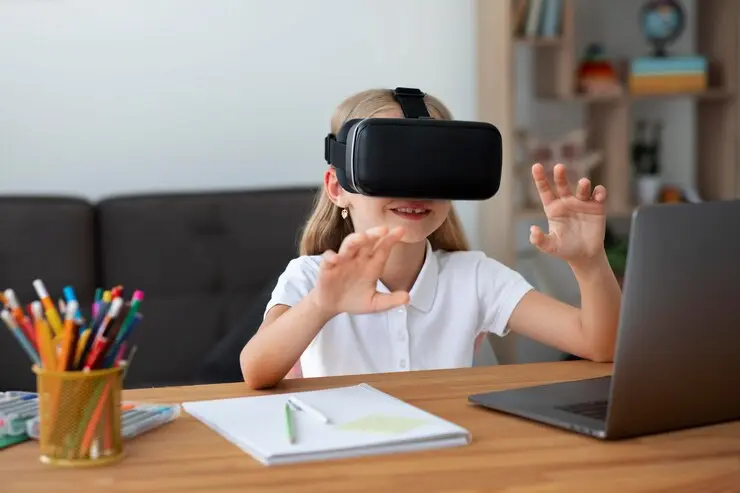Introduction to Augmented Reality in Education
Hey there! Have you ever wondered what it would be like if education wasn’t just confined to textbooks and whiteboards? Imagine diving into the human body to learn biology or walking through ancient civilizations while sitting in your classroom. This isn’t a sci-fi fantasy anymore; it’s real, and it’s called Augmented Reality (AR) in education. AR is transforming the traditional learning experience, making it more interactive, engaging, and, dare I say, fun!
AR isn’t just an add-on to the existing education system; it’s a game-changer. It enhances learning by overlaying digital information onto the real world. This means students can see and interact with 3D models, making complex subjects easier to understand. It’s like having a magic window that opens up to a world full of interactive learning opportunities.
The Impact of AR on Student Engagement
Let’s talk engagement. We all know that keeping students interested can be challenging. But, with AR, educators have a new tool in their arsenal. It brings lessons to life! Students can interact with 3D models, participate in immersive simulations, and experience abstract concepts in a tangible way. This hands-on approach not only grabs their attention but also keeps it, leading to better understanding and retention.
And it’s not just about looking cool. AR in education caters to various learning styles. Whether a student is a visual learner, an auditory learner, or a kinesthetic learner, AR has something for everyone. It makes learning personalized and inclusive, catering to individual needs and preferences.
Enhancing Learning with Interactive Content
The beauty of AR in education lies in its ability to transform static content into interactive experiences. Textbooks are no longer just pages to be read; they become interactive learning platforms. Imagine pointing your device at a page and watching a volcano erupt or a heart beating. This interactive content isn’t just more engaging; it helps students grasp complex concepts more easily.
Moreover, interactive AR content can be updated easily, keeping information current and relevant. It bridges the gap between theory and practice, providing students with up-to-date knowledge and real-world applications.
AR in Science Education: A New Dimension
Science education and AR are a match made in heaven. Complex subjects like physics, chemistry, and biology become more accessible when students can interact with 3D models. They can explore the human body, experiment with chemical reactions, or witness astronomical events, all within the safety of their classroom.
This immersive experience ignites curiosity and encourages exploration, making science not just a subject to be learned, but an adventure to be experienced. It’s like having a personal laboratory where the possibilities for discovery are endless.
Revolutionizing History and Geography Learning
History and geography can sometimes feel like a list of dates and places to memorize. But with AR, these subjects come alive. Students can take virtual tours of historical landmarks, walk through ancient cities, and witness historical events as if they were there.
This immersive approach not only makes learning more interesting but also more meaningful. It helps students understand the context and significance of historical events, fostering a deeper appreciation for the past.
Language Learning with AR: A New Approach
Language learning with AR opens up new horizons. Imagine learning French and being able to virtually visit a café in Paris, or learning Spanish while exploring a market in Barcelona. AR provides a context for language learning, making it more practical and relevant.
This immersive experience helps students understand the cultural nuances of a language, enhancing their communication skills and cultural awareness. It’s not just about learning a language; it’s about experiencing it.
AR in Special Education: A Ray of Hope
AR has a special role to play in special education. It offers customizable learning experiences that can be tailored to individual needs. For students with learning difficulties, AR provides a sensory-rich environment that can be adjusted to suit their learning pace and style.
This technology can be a lifeline for students who struggle with traditional learning methods. It offers them a way to learn that is more aligned with their needs, making education more accessible and inclusive.
The Challenges and Limitations of AR in Education
While AR in education offers many benefits, it’s not without its challenges. The cost of AR technology can be a barrier for many schools, especially those with limited resources. Additionally, there’s a learning curve for educators to effectively integrate AR into their teaching.
Moreover, there’s the issue of ensuring that AR content is educationally sound and aligns with curriculum standards. As with any technology, there’s also the risk of over-reliance, where the technology overshadows the core educational goals.
Preparing for the Future: AR in Education
As we look to the future, it’s clear that AR will play a significant role in education. It’s not just about keeping up with technology; it’s about reimagining how we learn. Preparing students and educators to embrace AR is crucial. This involves not only investing in technology but also in training and development.
The future of education with AR is not just about learning differently; it’s about learning better. It offers a more personalized, engaging, and effective learning experience. It’s an exciting time for education, and AR is leading the charge in this new era of learning.
Explore the rest of our website Tech Glints, intriguing articles await you! Interested in contributing? Simply click the contact button at the top right. Thank you!
